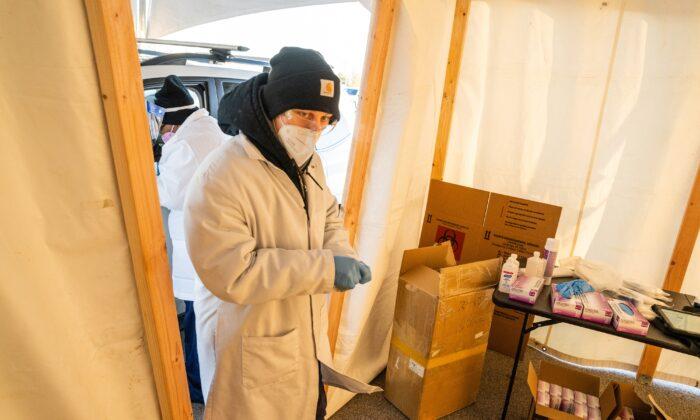Vaccinated people are more likely than the unvaccinated in recent months to be a COVID-19 case, hospitalization, or death in 25 states, according to an Epoch Times investigation.
In Kentucky in June, for example, 67 percent of the deaths were among the vaccinated, according to data obtained by The Epoch Times.
That same month, the vaccinated made up 65 percent of COVID-19 cases, 64 percent of COVID-19 hospitalizations, and 66 percent of COVID-19 deaths in Wisconsin.
The numbers are a drastic change from 2021.
After the mass vaccination campaign in the United States gained momentum, virtually every state reported unvaccinated people making up the vast majority of COVID-19 cases, hospitalizations, and deaths.
The numbers began tilting while the Delta virus variant was dominant. They have tilted even more since the Omicron variant displaced Delta, according to the newly collated numbers.
The Epoch Times compiled the data from state health department websites and databases. Some were obtained through records requests and have never before been made public.
The statistics underline how vaccines have increasingly performed worse as newer virus variants emerged, according to some experts.
They are “clear evidence that the vaccines are not working to prevent disease and death,” Dr. Robert Malone, who helped invent the messenger RNA utilized in the two most widely-administered vaccines, told The Epoch Times.
Others argue the raw numbers don’t contribute to analyzing vaccine effectiveness because they must first be adjusted to account for factors such as age.
“Unless one is able to correct for age and health status, this number is misleading, and does not lead to the conclusion vaccines are ineffective,” Dr. Roger Klein, a policy adviser to The Heartland Institute and a former adviser to the U.S. Centers for Disease Control and Prevention (CDC) and other U.S. health agencies, told The Epoch Times via email.
Some states provide age-adjusted numbers, as recommended by the CDC.
Click the dots in the upper right part of the graph to unveil the full-screen option and scroll through the graphics using the arrows at the bottom. Story continues below.
Data Reporting
Most states report at least one metric (cases, hospitalizations, deaths) by vaccination status. Some group the partially vaccinated with the unvaccinated when breaking down metrics.As vaccines have proven increasingly unable to prevent COVID-19 infection in the Omicron era, a growing number of states have followed the CDC in separating those who have received a booster from the fully vaccinated.
- Unvaccinated: people who have gotten zero shots.
- Partially vaccinated: people who have received one dose of the Moderna or Pfizer COVID-19 vaccines and people who have not seen 14 days elapse since their final dose of a primary series.
- Fully vaccinated: people who have completed a primary series of a vaccine.
- Boosted: people who have received at least one extra shot on top of the primary series.
Exceeded Expectations
In 14 states, the percentage of one or more so-called breakthrough metrics—post-vaccination cases, hospitalizations, and/or deaths—in recent months exceeded the percentage of the population that was vaccinated or fully vaccinated.In most cases, that was a single metric. But in several, it was multiple, and in one, it was all three.
- Alaska* (March): 3,995 breakthrough cases (64.5 percent of cases)
Vaccinated at the time: 59.1 percent of 5 and up - Idaho+ (June 5–July 2): 89 breakthrough hospitalizations (53 percent)
Fully vaccinated at the time: 52 percent - Kentucky* (June): 55 breakthrough deaths (67 percent)
Vaccinated at the time: 66 percent - Louisiana- (Aug. 7): 61 percent breakthrough deaths
Vaccinated at the time: 52 percent full, 6 percent partial - Minnesota+ (June 5–July 3): 29,660 breakthrough cases (71 percent); 107 breakthrough deaths (80 percent)
Fully vaccinated at the time: 66 percent - Mississippi* (April 1–Aug. 1): 54 percent of breakthrough deaths
Vaccinated at the time: 51.7 percent - Oklahoma* (June 5–July 5): 277 breakthrough hospitalizations (64 percent)
Vaccinated at the time, 5 and older: 51 percent - Rhode Island+ (June): 22 breakthrough deaths (76 percent)
Fully vaccinated at the time: 75.6 percent - South Dakota* (June): 141 breakthrough hospitalizations (74 percent); 8 breakthrough deaths (66.6 percent)
Vaccinated at the time: 58 percent - Utah+ (June 5–June 26): 17,856 breakthrough cases (67 percent); 623 hospitalizations (67 percent)
Fully vaccinated as of Aug. 8: 62 percent - Vermont+ (June): 32 breakthrough hospitalizations (84 percent); 10 breakthrough deaths (91 percent)
Fully vaccinated at the time: 78.6 percent - West Virginia+ (July 31): 175 breakthrough hospitalizations (55 percent)
Fully vaccinated at the time: 53.5 percent - Wisconsin+** (June): 31,702 breakthrough cases (65 percent); 634 breakthrough hospitalizations (64 percent); 69 breakthrough deaths (66 percent)
Fully vaccinated at the time: 61.5 percent - Wyoming+ (June): 3,672 breakthrough cases (62 percent); 9 breakthrough deaths (52 percent)
Fully vaccinated as of Aug. 15 (46.8 percent)
Adjusted Data
Some states adjust the data before releasing it, which is meant to eliminate differences that result from one population being different from another. The most common adjustment is for age.Age adjustment is used to compare populations directly “when the age distribution of who most commonly gets the disease, or seriously sick from the disease, is skewed,” according to the Wisconsin Department of Health Services. For COVID-19, older populations are more likely to experience severe illness and death, and are also more likely to be vaccinated, experts say.
While the raw numbers look bad for the vaccinated, after adjusting for age, the rates of COVID-19 hospitalizations and deaths in Wisconsin are higher for the unvaccinated throughout 2022 (cases have been higher in the vaccinated in recent months). That’s similar to most of the other states that report data as rates, some of which also provide raw numbers.
Wisconsin’s raw numbers were obtained through a records request.
Clinical trials and vaccine efficacy studies are the basis for determining vaccine effectiveness, Dr. Ryan Westergaard, chief medical officer for the state’s Bureau of Communicable Diseases, said during a briefing, adding that the research shows that protection against severe disease and death remains high.
Studies can help control for biases such as vaccinated people being more likely to get tested at sites, which report data to the state, versus at home, which is not counted, Dr. Leisha Nolen, Utah’s state epidemiologist, told The Epoch Times.
The studies show “the vaccines aren’t doing as well at keeping us from getting infected, but they are still keeping people out of the hospital,” Nolen told The Epoch Times.
Researchers reported data from a CDC-funded network of hospitals across 10 states from December 2021 to June 2022. The data showed that two doses of a vaccine, or a primary series, provided 57 to 68 percent protection against hospitalization through 149 days after vaccination, but dropped to as low as 24 percent 150 or more days after vaccination.
A third dose increased protection to 92 percent against BA.1, one of the subvariants, and 69 percent against BA.2, another subvariant. That protection dropped to 85 percent and 52 percent, respectively, after 120 or more days.

Majority Vaccinated
In 11 other states, the vaccinated made up a majority of at least one metric, but the proportion of vaccinated did not exceed the percentage of vaccinated.- Arizona+** (May): 62 percent breakthrough cases; 56.4 percent breakthrough hospitalizations
Fully vaccinated as of June 1: 62 percent - Connecticut+ (July 14–July 20): 2,116 breakthrough cases (56 percent); (July 25) 63 percent breakthrough hospitalizations
Fully vaccinated at the time: 73 percent - Georgia+ (June 4–July 1): 57,489 breakthrough cases (51 percent); 142 breakthrough deaths (54 percent)
Fully vaccinated at the time: 56 percent - Illinois+ (June 1–June 29): 205 breakthrough hospitalizations (49 percent); 195 breakthrough deaths (62 percent)
Fully vaccinated at the time as of Aug. 15: 65 percent - Maryland+ (June): 67.5 percent breakthrough cases, 70.6 percent breakthrough hospitalizations
Fully vaccinated as of May 31: 76 percent - Massachusetts+ (Aug. 2): 334 breakthrough hospitalized patients (60 percent); (June 25–July 1) 48 breakthrough deaths (77 percent)
Fully vaccinated as of July 18: 79 percent - Montana+ (May 14–July 8): 277 breakthrough hospitalizations (52 percent); 10 breakthrough deaths (48 percent)
Fully vaccinated at the time: 53 percent - New Mexico+** (July 4–Aug. 1): 15,520 breakthrough cases (62 percent); 398 breakthrough hospitalizations (55 percent); 45 breakthrough deaths (67 percent)
Fully vaccinated as of Aug. 9: 69 percent - Oregon+ (June): 27,092 breakthrough cases (59 percent); 83 breakthrough deaths (51 percent)
Fully vaccinated as of Aug. 16: 70 percent - Pennsylvania+ (April): 25,077 breakthrough cases (61 percent)
Fully vaccinated at the time: 65 percent - Tennessee- (July 1–July 8): 73 breakthrough hospitalizations (52 percent)
Vaccinated at the time: 52 percent fully, 5.3 percent partially

Other Studies
Vaccine-provided protection began waning against infection and, to a lesser extent, against severe illness in 2021, when the Delta variant was dominant. Since Omicron emerged in December 2021, that trend has quickened.“It’s really not possible to predict what this virus is going to do, and I think it makes sense to be prepared with these boosters, which contain components of a BA.4 and BA.5 as well as the so-called archival Wuhan strain,” Dr. Cody Meissner, one of the U.S. Food and Drug Administration’s external vaccine advisers, told The Epoch Times.
Some experts like Meissner say most people, including all adults, should still get vaccinated. Others note healthy individuals are at little risk from COVID-19, especially new variants, and say that the more recent data suggest little benefit for many.
“What we’re looking at now is a sign of progress of a number of factors, primarily [that] the vaccinated can still catch and spread the COVID-19 virus,” Dr. Steven Hatfill, a virologist, told The Epoch Times.
“The cost-benefit ratio now especially for the younger age groups has disappeared,” he added later.
Remaining States
Of the remaining 25 states, eight reported the unvaccinated as making up more of the COVID-19 cases, hospitalizations, and deaths.- California** (June): 215,900 unvaccinated cases (51.7 percent); 5,057 unvaccinated hospitalizations (52 percent); 413 unvaccinated deaths (59 percent)
Unvaccinated at the time: 20 percent - Colorado**+ (June 26–July 3): 353.2 unvaccinated cases, 145.5 fully vaccinated, 244.3 boosted; 13 unvaccinated hospitalizations, 5.6 fully vaccinated, 4.9 boosted; (May 25–June 1): 54.7 unvaccinated deaths, 35.2 vaccinated, 18.1 boosted
Unvaccinated at the time: 20.5 percent - Indiana* (Jan. 1–late July): 264,779 unvaccinated cases (50.7 percent); 90 percent unvaccinated hospitalizations, 35 percent unvaccinated deaths
Not fully vaccinated as of July 24: 45 percent - Maine*+ (July 16–July 23): 333 not fully vaccinated cases, 68.5 fully vaccinated; 17 not fully vaccinated hospitalizations, 1.8 fully vaccinated; 0.5 not fully vaccinated deaths, 0 vaccinated
Not fully vaccinated at the time: 25.2 percent - Nebraska* (June 26–July 23): 11,048 not fully vaccinated cases (59 percent); 3,412 not fully vaccinated hospitalizations (97 percent); deaths unclear
Not fully vaccinated at the time: 35 percent - New Jersey*+ (as of July 16): 565 not fully vaccinated cases, 117 fully vaccinated, 199 boosted; 16 not fully vaccinated hospitalizations, 3 fully vaccinated, 5.5 boosted; 0.35 not fully vaccinated deaths, 0.06 fully vaccinated, 0.1 boosted
Not fully vaccinated as of Aug. 17: 33 percent - North Carolina* (July 31–Aug. 6): cases not available; 50.6 percent not fully vaccinated hospitalizations; death rate per 100,000 (June 30–July 30): 2.2 not fully vaccinated, 0.4 fully vaccinated, 0.2 boosted
Not fully vaccinated as of Aug. 18: 37 percent - Texas*+ (June 18–June 25): 334.4 unvaccinated cases, 163.9 fully vaccinated; hospitalizations not available; 0.5 unvaccinated deaths, 0.2 fully vaccinated
Not fully vaccinated as of Aug. 10: 38 percent
CDC Reporting
Earlier in the pandemic, when the unvaccinated were making up the bulk of the metrics across the country, U.S. officials and news outlets cited the state-level data as proof the vaccines worked.The data is presented as incidence rates. Efforts to obtain the raw numbers have not yet been successful. According to the rates, the unvaccinated were 2.1 times more likely to test positive in June and five times more likely to die from COVID-19 in June than the fully vaccinated.
Most states only report age-adjusted data or only present raw data in large chunks, such as from the beginning of the pandemic. The Epoch Times reviewed percentages and numbers from states that do report them, and obtained monthly or weekly breakdowns from some states. It also obtained unadjusted data from others that have never been reported before. Some states stopped reporting metrics by vaccination status after inquiries from The Epoch Times. Their reports were saved before they stopped.






